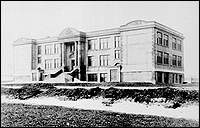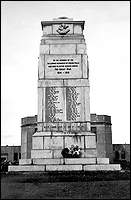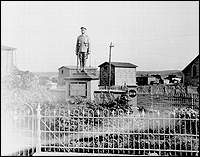|


|

|

Commemorations At Home
Across Newfoundland, communities large and small looked for suitable ways to
commemorate their war dead. The residents of Botwood raised enough money to purchase a 12-foot grey
granite obelisk from D. Beveridge and Son of Perth, Scotland. The obelisk
was unveiled July 1, 1921. Inscribed on it were the names of those who had made the supreme
sacrifice, their epitaph, “Their names liveth for evermore.” In the small
outport community of Arnold’s Cove, some 30 families purchased a plain granite shaft which
they erected as a memorial to their war dead on August 7, 1921.
The fraternal organizations were also involved. On September 8, 1921, the Loyal Orange Association in Trinity
erected a monument with the names of the five Orangemen and
ten non-Orangemen who had fallen inscribed on what became a community memorial (“Trinity’s” 51).
On the Burin Peninsula, monuments were erected at Fortune, Burin, and
Lamaline. The full cost of the Fortune war memorial was met by the people themselves with the
assistance of the Great War Veterans Association. In Grand
Falls on July 23, 1922, a replica of the Cenotaph in London was unveiled on Station Road. The
$8,000 monument was paid for by the people of Grand Falls with assistance from the
Anglo-Newfoundland Development Company.
Memorial University College, Parade Street, St. John’s, 1924.
Courtesy of the Provincial Archives of Newfoundland and Labrador (PANL NA-39-96), St. John’s,
Newfoundland.
 (41 Kb)
(41 Kb)
|
 |

|

|
 |
War Memorial 1914–18, Grand Falls-Windsor, n.d.
Courtesy of the Provincial Archives of Newfoundland and Labrador (PANL A-37-56), St. John’s,
Newfoundland.
 (32 Kb)
(32 Kb)
|
War Memorial, Grand Bank, n.d.
Courtesy of the Provincial Archives of Newfoundland and Labrador (PANL NA-60-88), St. John’s,
Newfoundland.
 (42 Kb)
(42 Kb)
|
 |

|
There were other permanent forms of memorials established as well. The Knights of
Columbus in St. John’s established the Knights of Columbus Memorial School to promote Catholic education in
Newfoundland. The school was built as an extension of the already existing Academy of Our
Lady of Mercy near the Catholic Cathedral. The building contained 12 large classrooms, a
domestic science room, music and dressing rooms, a water fountain and a large auditorium.
Perhaps the greatest legacy left by the Great War was the establishment of
the Memorial University College in 1925. It was decided that the greatest legacy
would be to leave an institution that would help to augment the woefully inadequate levels of
education in Newfoundland. In 1949, the institution received full degree-granting status
and became the Memorial University of Newfoundland. Its accomplishments and
contribution to the life of the province stands as a fitting tribute to the young men who
lost their lives in the service of their country during the Great War.

|

|
 |